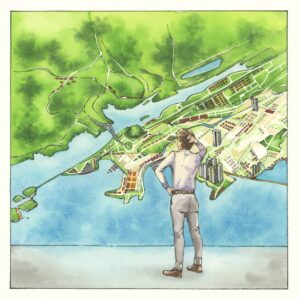This article will provide a broad, high-level overview of the process of applying for legal residency in Panama. For most of the residency visas that our office manages, the residency application processes themselves are pretty much identical. The distinguishing factors relate more to a.) the documents that go into the application package, and b.) the term of the residency itself, once approved (1-year, 2-year, or permanent).
Pretty much any of the residency visa programs are going to require you to physically be in Panama for a few days to submit the application package. And they pretty much all start with a 6-month provisional residency card that allows you to remain in Panama (and to come and go as you please) during the up to 6 months it will take for your longer-term residency to be approved.
One exception is the Qualified Investor Visa (AKA Panama’s Golden Visa), which allows your attorney to submit your application before you arrive, and allows for an expedited approval process that can usually be accomplished within around 45 business days.
5 Days in Panama
We generally ask our clients to plan to be in Panama for at least 5 business days to submit the residency application. But allow me to clear up one potential misconception. There aren’t going to be 5 days of things that you’ll have to do.
Actually, in most cases, you aren’t going to have to spend much time during your Panama trip in meetings or sitting in government offices. That’s because—in most cases—you will have already completed your homework before you arrive to Panama.
Here is what the typical trip will look like—at least as it relates to the submission of your residency application:
On Business Day-1, we will meet in the TIL offices to get started. This is usually going to be about a 45-minute meeting. We will receive your original documents with the apostilles and Consular authentications. You’ll deliver your passport-size photos (or you’ll step into our photo studio if you happen to have forgotten them). We’ll also get your signature on some docs we will have prepared in advance, including a limited power of attorney (PoA) that allows our office to submit your application and to receive notifications related to your application on your behalf. And, finally, we will need to take your passport for a few days.
That’s right—you are going to be without your passport for a few days. But we will provide some paperwork for you to carry with you explaining to anyone who asks: a.) why you don’t have your passport, and b.) why we have your passport.
Over the next few days, our team will be notariing your signatures, registering your passport, stamping documents with Panama’s Ministry of Foreign Affairs, and submitting your residency application. In the meantime, you’ll be relaxing by the pool, exploring Panama City, or keeping up with work back at home (if necessary). Or, if you want to work on things like starting the process to get your Panama driver’s license, opening a bank account, or looking at apartments, then you’ll have plenty of time for that, as well.
Then—by Business Day-4 or Day-5—we will be ready for you to accompany one of us to Panama’s immigration office to get your provisional residency card. This is usually going to be an early-morning meeting at 7:00 a.m., which usually allows you to beat the crowds. You can generally plan to be out within 1 hour.
So, during those 5 business days, you are going to have plenty of time to relax and explore the City (or areas not too far outside of the City). The reason we recommend that you stay in or near the City, is because we are going to have your passport. So, you won’t be able to jump on to a flight to Bocas del Toro or somewhere too far away.
Becoming a (Provisional) Resident
On the morning that you go to the immigration office on the tail-end of of the 5-business days, you are going to walk into Panama’s immigration office as a tourist, and you are going to step out as a Panama resident. A provisional Panama resident.
So, what does it mean to be a provisional Panama resident?
Well, perhaps most importantly, the provisional residency card allows you to stay in Panama during the up to 6 months it will usually take for your long-term residency to be approved.
It also means that you can leave Panama and re-enter as you please during the next 6 months, because your provisional residency comes with a multi-entry and exit visa. Oh, and when you travel into Panama you no longer have to show evidence of a departure flight. And you can get into the “foreign residents” line when going through Customs.
A provisional residency card is also a demonstrable tie to Panama. Local banks like to see this and will be more receptive to you if you wish to open a bank account in Panama.
By the way, there a number of visa programs that require you to have a bank account in Panama before you submit the residency application, so our office can definitely help you navigate this even before you have your provisional residency card.
Finally, having provisional Panama residency means that you are no longer a tourist. You may know that toursts are able to drive in Panama using their foreign driver’s license for up to 90 days from the date that they entered Panama. But once you stop being a tourist, this no longer applies to you. So, if you drove to the immigration office to pick up your provisional residency, then you technically shouldn’t get back behind the wheel to drive back to your hotel or AirBNB. Because as a provisional resident, you are now eligible to get your Panama driver’s license!
What Happens Next?
Over the next few months, our team will be monitoring the progress of your application. Remember, on Business Day-1, you signed a limited PoA allowing our office to submit your application and to receive notifications on your behalf. So, at some point—usually within the 6 months—when your long-term residency is approved, someone from our team will need to go back to the immigration office to receive the resolution approving your residency. We call this “being notified”, because this is when you are formally notified (through us) that you are now a long-term resident.
By the way, we’ll need a bit of help from you in order to “be notified” and receive the resolution. If you happen to be in Panama, then we will need to take your passport and residency back for one more day to take to the immigration office. The process of “being notified” takes just a couple hours. If you are not in Panama, then we will need your flight reservation or a copy of your ticket from when you left Panama.
Once we have “been notified”, you’ll receive a message from us saying, “Good news, your long-term residency has been approved!” And we’ll invite you to plan when you’d like to go back to the immigration office to get your long-term residency card.
But if you aren’t planning to be back in Panama any time soon, then you won’t need to worry at all. That’s because you will have up to 2 years counted from the date of your last departure to come back to Panama and pick up your long-term residency card. Even if your 6 month residency card has expired, you can show it together with a copy of the resolution approving your long-term residency, and you should be able toa void having to show evidence of a return-flight reservation the next time you enter Panama.
The reason is—and this is important to remember—the main obligation to maintain your Panama residency is that you enter Panama at least one time every two years. If you spend more than 2 years outside of Panama, your residency can be suspended. There is no minimum time that you need to spend, and you could even just have a layover long enough to pass through customs and stamp your passport. But you need to come to Panama at least once every 2 years to maintain your residency here.
And since the day you walked into Panama’s immigration office for the first time to get your provisional residency card, you never stopped being a Panama resident. Your provisional residency just rolled into your longer-term residency.
Beyond the 2nd Trip to the Immigration Office
If you have applied and qualified for a 1- or 2-year residency, then the clock starts ticking with the issuance of the resolution (not when you actually pick up your next residency card). And the next steps will depend which residency strategy you are pursuing.
For example, if you applied for something like the Friendly Nations Visa, then your long-term residency was a 2-year residency card. And your next planned step will probably be to apply for permanent residency. You can start that process any time after month-21 of your 2-year residency. At that point, you’ll need to submit the application for permanent residency, showing that you still meet the requirements.
But this time you won’t need to chase down foreign documents (police reports, marriage certificate, etc). You’ll go back to the immigration office for a 3rd time to get a new 6-month provisional residency card, and generally during that 6-month period your permanent residency will be approved.
And once you’ve applied and been approved for permanent residency, then this will likely be your final trip to the immigration office for the application process. You may need to go back and get a new residency card if/when you renew your passport, because your passport number will change. But if you’ve elected to get the E-cedula, then you’ll probably just thrown that permanent residency card into a box somewhere and forget about it.
Otherwise, the only time you may go back to the immigration office will be to update them on changes to key information that you provided when you applied. For example, the immigration office is now requiring that you update them with any changes to your long-term address in Panama within 30 days of the change becoming effective. And they are assessing a $100 fine (per person) for any failure to update within the prescribed 30-day period. You can do this yourself at the immigration office, or you can hire our office to update them for you.
“Usually” within 6 Months
You may have noticed that a few paragraphs back, we casually mentioned that the long-term residency will “usually” be approved within the 6 months that your provisional residency card is valid. Actually, we could replace the word “usually” with “almost always”. And, actually more often than not, the processing time is between 3-5 months.
So, what happens with the approvals that take a bit longer?
Well, over the last couple of years, we had one client whose long-term residency under the Pensionado Visa was approved on the very last day of the 6-months. She was understandably a bit stressed, but she is now a permanent resident of Panama.
And we have also worked with just a handful of people whose approvals have gone beyond the 6 month provisional residency. In the unlikely scenario that this happens we simply request an extension of the provisional residency for an additional 6-month period.
Bottom Line?
Most of the visa applications that we process at The Independent Lawyer will require you to physically be in Panama in Panama for a few days to submit the application. We generally ask our clients to be here for 5 business days. There won’t be a whole lot you’ll have to do during that week, and you’ll have plenty of time do other things.
But we will have your passport for a few days, so most people prefer to remain in Panama City or not too far from Panama City. And at the end of that first trip, you’ll receive your provisional residency card, which allows you to remain in Panama (and to come and go as much and as often as you want) during the 6 months it will take for your longer-term residency to be approved.
Once your long-term residency is approved, you’ll need to plan a trip back to Panama to visit the immigration office a 2nd time and to receive your long-term residency card. But you won’t have to rush back—in fact, you’ll have a window of up to 2 years counted from the date of your last departure from Panama.
Did you find this article helpful? Did we miss anything important? Write to us at info@theindependentlawyer.com.







